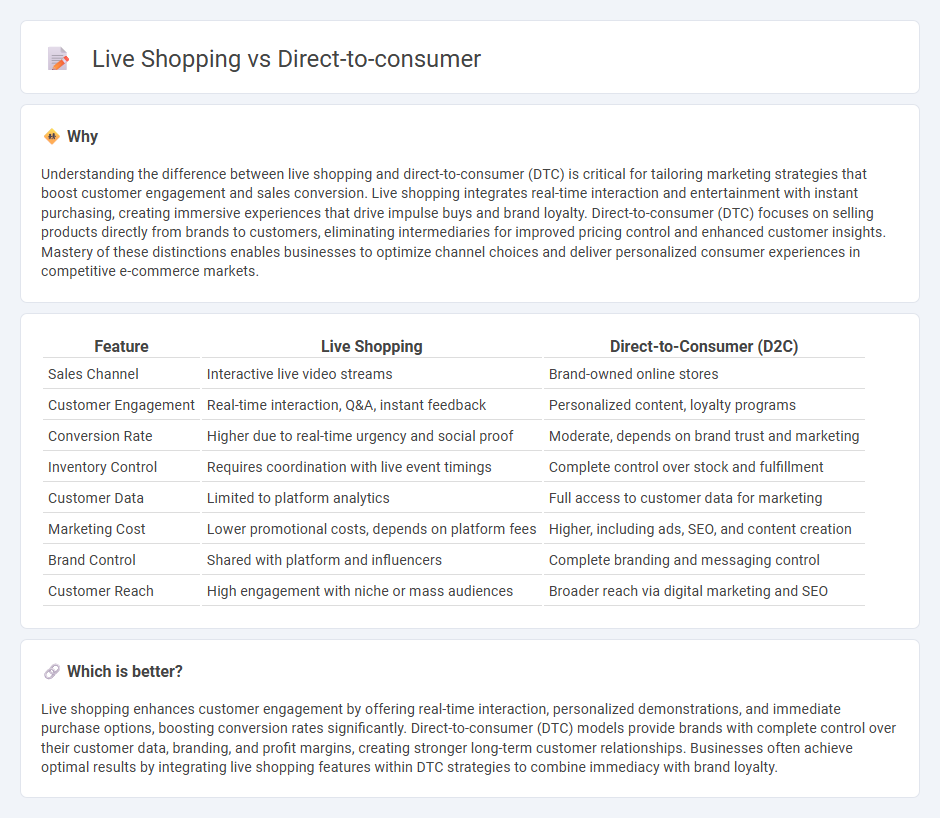
Live shopping integrates real-time interaction and entertainment, enhancing customer engagement and driving immediate purchase decisions. Direct-to-consumer (DTC) eliminates intermediaries, offering brands greater control over customer data, pricing, and personalized experiences. Discover how these strategies transform commerce and redefine consumer-brand relationships.
Why it is important
Understanding the difference between live shopping and direct-to-consumer (DTC) is critical for tailoring marketing strategies that boost customer engagement and sales conversion. Live shopping integrates real-time interaction and entertainment with instant purchasing, creating immersive experiences that drive impulse buys and brand loyalty. Direct-to-consumer (DTC) focuses on selling products directly from brands to customers, eliminating intermediaries for improved pricing control and enhanced customer insights. Mastery of these distinctions enables businesses to optimize channel choices and deliver personalized consumer experiences in competitive e-commerce markets.
Comparison Table
| Feature | Live Shopping | Direct-to-Consumer (D2C) |
|---|---|---|
| Sales Channel | Interactive live video streams | Brand-owned online stores |
| Customer Engagement | Real-time interaction, Q&A, instant feedback | Personalized content, loyalty programs |
| Conversion Rate | Higher due to real-time urgency and social proof | Moderate, depends on brand trust and marketing |
| Inventory Control | Requires coordination with live event timings | Complete control over stock and fulfillment |
| Customer Data | Limited to platform analytics | Full access to customer data for marketing |
| Marketing Cost | Lower promotional costs, depends on platform fees | Higher, including ads, SEO, and content creation |
| Brand Control | Shared with platform and influencers | Complete branding and messaging control |
| Customer Reach | High engagement with niche or mass audiences | Broader reach via digital marketing and SEO |
Which is better?
Live shopping enhances customer engagement by offering real-time interaction, personalized demonstrations, and immediate purchase options, boosting conversion rates significantly. Direct-to-consumer (DTC) models provide brands with complete control over their customer data, branding, and profit margins, creating stronger long-term customer relationships. Businesses often achieve optimal results by integrating live shopping features within DTC strategies to combine immediacy with brand loyalty.
Connection
Live shopping revolutionizes commerce by enabling brands to connect directly with consumers through real-time interactive video streams, enhancing customer engagement and boosting sales conversions. Direct-to-consumer (DTC) brands leverage live shopping platforms to bypass traditional retail channels, fostering personalized shopping experiences and gathering instant consumer feedback. This synergy between live shopping and DTC models drives increased brand loyalty, accelerates market responsiveness, and maximizes profit margins.
Key Terms
Distribution Channel
Direct-to-consumer (DTC) channels enable brands to sell products directly to customers through online stores or physical outlets, bypassing traditional retail intermediaries for greater control over brand experience and customer data. Live shopping combines real-time video streaming with e-commerce, leveraging interactive platforms like Instagram Live or TikTok to provide an immersive, engaging shopping experience that drives impulse purchases. Explore how optimizing these distribution channels can enhance revenue growth and strengthen customer relationships.
Consumer Engagement
Direct-to-consumer (DTC) models prioritize personalized customer interactions by offering exclusive products and tailored experiences, increasing brand loyalty and satisfaction. Live shopping leverages real-time video streams and interactive features to create immersive, social buying experiences that boost consumer engagement and conversion rates. Discover how these strategies enhance engagement and drive sales by exploring the latest trends in consumer behavior.
Conversion Rate
Direct-to-consumer (DTC) models often achieve higher conversion rates by providing personalized experiences and eliminating intermediaries, resulting in streamlined purchasing journeys. Live shopping enhances conversion rates further by creating real-time engagement and urgency through interactive product demonstrations and instant purchasing options. Explore detailed strategies to maximize conversion rates in both DTC and live shopping formats.
Source and External Links
Direct-to-consumer - Direct-to-consumer (DTC or D2C) is a business model where brands sell products directly to customers, bypassing third-party retailers or wholesalers, often online but sometimes complemented with physical retail spaces.
Direct to Consumer (D2C) Guide - DTC means a brand sells straight to the end user without retail partners, often using ecommerce websites, social commerce, or apps, and this approach is growing rapidly with sales expected to exceed $200 billion by 2024.
What Is Direct-to-Consumer? Everything You Need To Know - The DTC model enables brands to control the customer experience, marketing, and fulfillment by selling directly, which helps build stronger relationships and gain first-hand customer insights.
 dowidth.com
dowidth.com